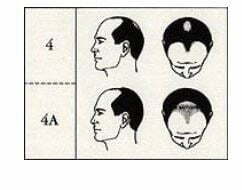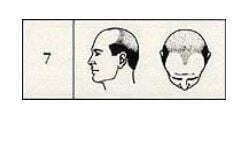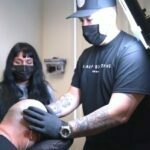Are you considering scalp micropigmentation for you or perhaps for someone you know? Perhaps you’ve heard about microblading for fuller brows but what if we tell you that you can do something similar to cover bold spots and other hair loss issues on your scalp? If you think this would be beneficial for you, then keep reading and learn more about scalp micropigmentation cost.
With scalp micropigmentation you can leave your hair loss issues in the past, it is a form of permanent makeup that uses tiny, layered dots in different hues of black to replicate the look of a shadow on your scalp. This process is highly useful for people who has experienced all forms of hair loss including cancer, alopecia, thinning hair, etc.
Thanks to scalp micropigmentation many have experienced a sudden increase in self-confidence making you forget about your pattern of baldness and other issues in the past. Ultimately, it’s essential to remember that SMP is an investment. But if done correctly it can be a total game-changer. Find out more about scalp micropigmentation cost.
Scalp Micropigmentation Cost FAQ’s
How much does scalp micropigmentation cost?
The total scalp micropigmentation cost will depend on the practitioner and the extent of the treatment. Cost estimates range from $1,800 to $4,000 for a typical treatment for balding. Meanwhile, scar treatment can run less, between $1,200 to $2,500; since it is usually covering less area.
How long does scalp micropigmentation last?
Most of all the skills of the technician and the techniques used will play an important part in how long it will last. The rough estimate that is given to clients of how long their procedure will last is around the five years mark. It’s important to make sure our clients know that SMP, hair tattoos; are not permanent.
Is scalp micropigmentation a good idea?
Scalp Micropigmentation (SMP) is a remedy for hair loss that’s suitable for many different situations. It’s an option many men turn to when other hair loss treatments have failed them. And, unlike other ways of dealing with hair loss, Scalp Micropigmentation is 100% effective.
How to find the right SMP practitioner for you?
Before you decide on an SMP practitioner, it’s crucial to do your homework. Make sure to visit the office where the service will be performed.
What should a high-quality SMP treatment center offer?
- Certification of SMP training
- Body art practitioner license on display (depending on state requirements)
- Bloodborne pathogens certification
- County health permit
- A clean and sterile environment with a sink
- Packaged needles that can be opened in front of the client
- Barrier protection during treatment (nitrile gloves, mask, barrier tape, and guards on SMP treatment device)
- Be sure to ask the artist how many appointments they schedule each day. This kind of service is time-consuming and requires an intense amount of focus.
- You’ll also want to find out more about the practitioner’s background, such as who trained them, the length of their training, and seeing their portfolio.
Scalp Micropigmentation Cost: What to know
- Micropigmentation is a very intricate procedure. On average, there are over 100,000 follicles on the human head; this means our skilled practitioners, guided by cutting-edge technology, must carefully implant pigments by hand upwards of 1,250 times per square inch.
- The price to accomplish this feat generally falls between $1,800 to $3,200 for what it’s considered the average client’s needs and desired look.
- The exact price of a scalp micropigmentation treatment, however, may be higher or lower depending on a number of factors.
- Some places offer financing options for your scalp micropigmentation treatment.
What factors play a role in the cost of your scalp micropigmentation procedure?
The cost of each procedure varies based on several factors, including the size of the treatment area, your type of skin, if you have scarring, and how dense your original hair is.
Treatment Area
One of the most important factors that dictate the price of micropigmentation is the cumulative size of the treatment area determined by the size of the head and the extent of the hair loss.
The majority of clients suffer from male pattern baldness, the severity of which is determined by The Norwood scale. If you are in the earlier stages of balding, treatment will be less costly compared to addressing the larger treatment areas associated with the later stages.
What are the stages of male pattern baldness on the Norwood scale?
- Stage I: Minimal hair loss or recession of the hairline. Cost is typically in the range of $1,200 to $1,800

- Stage II: The hairline begins to thin typically in an “m” shaped pattern at the temples. Triangular and typically symmetrical areas of recession at the front temporal area. Cost is typically in the range of $2,000 – $2,500
- Stage III: The “m” pattern first seen in the previous stage deepens. Most scalps at this stage have deep symmetrical recession showing at the temples that are bare or only sparsely covered by hair. Cost is typically in the range of $2,700 – $3,000
- Stage IV: Hair recedes more dramatically at the sides in this stage, often leaving a triangular island of hair at the front of the head. The bald spot in the back of the head is more noticeable. The bigger pattern on the vertex and hairline. Cost is typically in the range of $3,000 – $3,500

- Stage V: The two main regions of hair loss in the front and back are still distinct, but the band that separates them starts to thin. Patterns at both sites are bigger but a thin division line is still present. Cost is typically in the range of $3,500 – $4,000
- Stage VI: The two main areas of hair loss unite in this stage. Hair continues to recede around the sides of the head. The bridge is gone but several strands of short fine hair may remain. Cost is typically in the range of $4,000 – $4,500
- Stage VII: In this stage, only the hair around the back and sides of the head remain, forming the classic “horseshoe” pattern. The most severe form of hair loss. Little hair on the front or top of the head. Cost is typically in the range of $4,500 – $5,500

How is pricing for other conditions established?
Pricing for those suffering from other conditions that result in hair loss in the form of general thinning, patching, or complete baldness will be established in the same way: the cumulative size of the treatment area determined by the size of the head and the extent of the hair loss.
Skin Type
- Excessively dry, flaky skin; older skin; severe acne; moles; damaged skin; or highly sensitive skin may necessitate extra time and care.
- Extremely thick skin might also require extra treatment time; the thicker the skin, the more pressure is needed in order for the needles to penetrate through to the deeper layers.
- Thinner skin requires less pressure on the pen, which allows for a quick hand motion and shortens the overall treatment time.
- New skin may also affect the procedure. Sometimes collagen forms at the site of the new grafts, which makes the skin very soft and act like a sponge when the pigment is injected into that area.
Scarring
- The presence of scarring may also require special time and consideration from a technician. Since hair does not grow over scar tissue, and micropigmentation is meant to mimic natural hair stubble, other accommodations must be made.
- For lighter cars, implementing a specialized technique along with our normal micropigmentation treatment will usually be enough to hide the blemish.
- For more pronounced scarring, technicians might recommend focusing on the scar treatment before proceeding with the full scalp micropigmentation treatment. For further information read our story on Scar Camouflage Micropigmentation used to Cover Up Hair Transplant Scars
Hair Density and Style
- Even with a full head of hair, the natural density of one’s hair can vary greatly from person to person.
For the most natural look, it is taken into account the fullness and distribution of your natural hair. - The style you choose will also determine the density of the treatment and the time required to accomplish the look. A “wet shave” look is a very light treatment option, while a classic fade needs extra density in places which means extra treatment time. What to know about hair density? Then check out our story on Hair Density Simulation.



